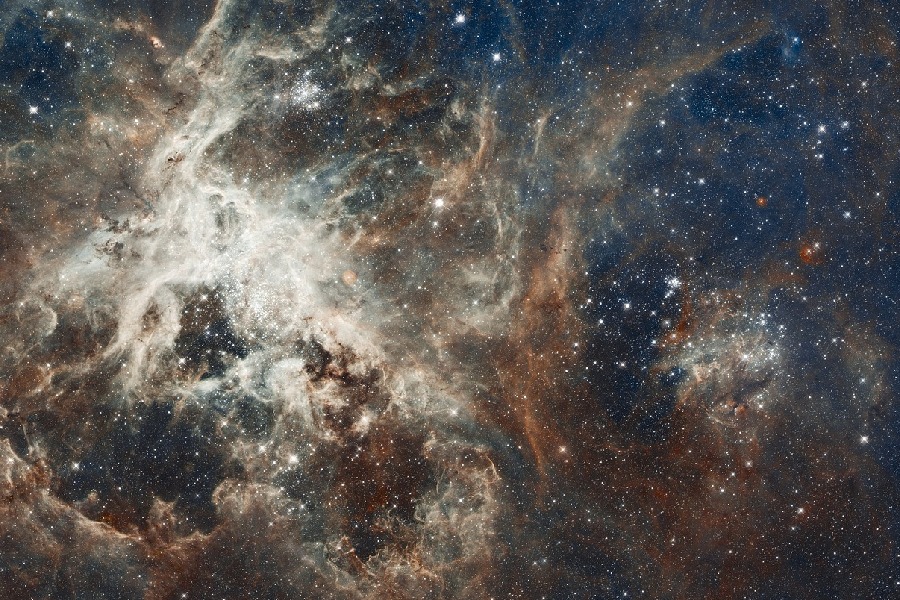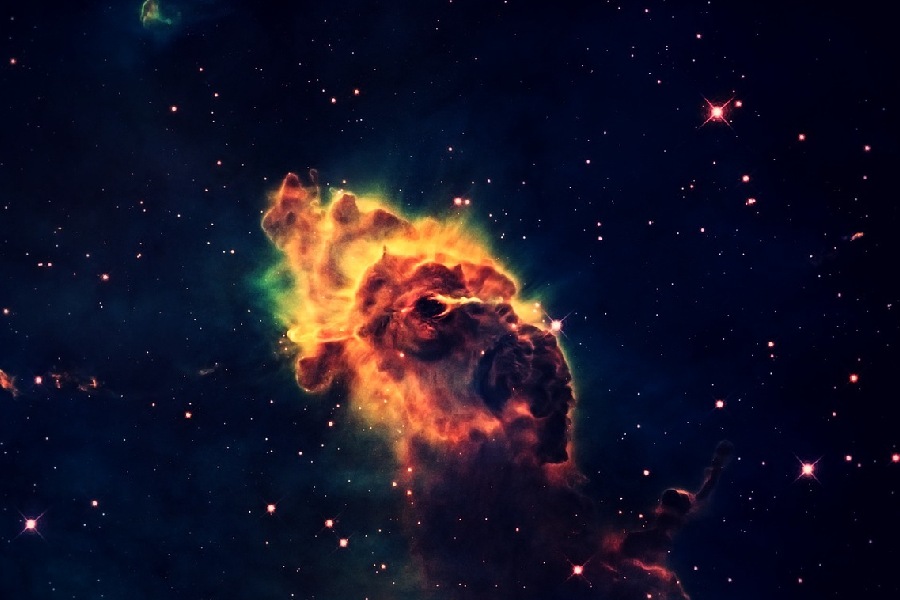Have you ever gazed upon the vast expanse of stars in the night sky and pondered how the universe was created? Unraveling the origins of the cosmos represents a profound quest taken up by humanity across cultures and history.
Advances from Einstein’s theories of relativity to observations of faint radiation remnants have unlocked pieces surrounding how the universe was created and evolved over billions of years.
This article explores prevailing ideas on what set existence in motion, back to an infinitesimal point when space and time emerged. New findings continually uncover clues surrounding the universe creation concepts, though mysteries endure.
Join us in reviewing remarkable discoveries made in cosmology and astrophysics that have pushed knowledge back toward an initial cosmic dawn. A breathtaking narrative emerges, though its opening chapter still awaits full focus, making us wonder what forces stirred the universe to life.
How the Universe Was Created?
So, how the universe was created and what was before the Big Bang? The prevailing scientific view is that the universe started with a massive expansion event about 13.8 billion years ago known as the Big Bang. Prior to this, the entire cosmos was concentrated into an extremely dense and hot point called a singularity.
What set off the Big Bang remains unknown, but this singularity began expanding rapidly in a fraction of a second, kicking off space and time itself. In the aftermath, the intensely hot, energetic universe filled with fundamental particles rapidly cooled, allowing particles to coalesce as hydrogen and helium gas.
Over hundreds of millions of years, gravity condensed this gas into the first stars and galaxies. Continued expansion and structural growth eventually formed the vast cosmic web of galaxies observed across the observable universe today.
So, in summary, the prevailing theory supported by scientific evidence is that the universe was created with the Big Bang – a massive expansion event from an initial infinitesimal singularity point. We are still searching for what physical laws or processes defined that initial state or triggered this monumental expansion.

History of Theories of Creation
Ancient creation myths
Many ancient cultures developed mythical stories to explain the universe’s beginnings. Babylonian and Greek stories depicted primordial deities or beings such as Gaia, giving birth to fundamental elements like the heavens, sky, and earth. Common themes envision creation emerging from emptiness or a watery abyss.
The earliest concepts dominantly featured divine action forging realms of existence. Indian philosophy conceived endless cycles of expansion and destruction within a constantly regenerating cosmos.
Chinese records tracing to the 4th century BCE recount cosmic eggs splitting to form complementary opposites like heavens and earth. Shared notions saw consciousness or archetypal forces bringing forth reality as opposed to physical events or creators.
Classical cosmology models
Classical Greek scholars, including Aristotle, formulated an Earth-centered model of concentric spheres carrying planets around a static cosmos. Influential through the Renaissance, this steady-state model dominated for over a millennium.
Challenges emerged as astronomers observed shifts contrary to theory, spurring revisions to maintain centered, bounded models against growing signs of vast scale.
Big Bang Theory
What is the Big Bang theory?
The Big Bang theory is the prevailing cosmological explanation for how the universe began over 13 billion years ago and evolved into its current state. Prior to the Big Bang, the entirety of space, matter, and energy was believed to have occupied an infinitesimally tiny point called a singularity.
The theory recounts that the universe expanded rapidly from this hot and extremely dense initial state. Over time, it cooled, and fundamental particles coalesced into simple elements and, eventually, stars and galaxies.
The Big Bang theory transformed modern cosmology by rationally accounting for the origin and large-scale structure of the universe supported by multiple lines of evidence.
Basic principles
The singularity represents the beginning point that contains all the initial mass and energy. Its contents began expanding rapidly in an event known as the Big Bang about 13.8 billion years ago, marking the start of space and time.
This spawned hot, dense radiation and fundamental particles like quarks and electrons. As expansion cooled the infant universe over its first after 380,000 years, these constituents formed neutrons, protons, and nuclei. Atoms later combined into gas clouds that gravity condensed into the first stars and galaxies.
Evidence for Big Bang theory
Compelling verification for the Big Bang theory comes from observations of leftover radiation called ‘cosmic microwave background’ measured persisting across the universe corresponding to relic heat from the early expansion.
Additional supporting evidence stems from computer models accurately showing light element formation through fusion during the first minutes, precisely matching ratios of hydrogen, helium, and lithium astronomers observe. Expansion redshift measurements also confirm that galaxies continue moving apart as expected from an initial outward push.
Formation of elements
The early universe only contained lighter elements, hydrogen, helium, and traces of lithium. Heavier elements formed later inside stars. Nuclear fusion within stars combines light nuclei into heavier ones. Supernova explosions disperse fused atoms. This enrichment accumulates over successive stellar generations.
Modern telescopes find heavier elements abundant, indicating numerous ancient star cycles fused matter, synthesizing increasing complexity even from the dawn of space and time.

Other Theories on the Creation of the Universe
Introduction to alternatives
While the Big Bang theory is widely accepted, diverse perspectives on the genesis of the cosmos have existed in scientific history. Alternative concepts envision different processes, from steady states to quantum beginnings, though observational evidence for confirmation remains elusive.
Exploring these ideas furthers discourse even if foundational questions remain unsettled.
A diversity of theories allows for comparing explanatory models using emerging evidence. While the Big Bang aligns with measurable data points, scientists acknowledge many unsolved mysteries regarding the earliest instants of creation.
Ruling out competing ideas bolsters confidence without fully reconciling unknowns preceding observable expansion.
Steady state theory
First formulated in 1948 by Fred Hoyle, the steady state theory contests that the universe continuously expands but does not evolve over time. It postulates constant large-scale features while new matter randomly forms to fill voids, maintaining visible density. This principle defied growing evidence that galaxies once looked different.
While the steady state theory aimed to explain cosmic origins devoid of a definite beginning, observations like cosmic background radiation and star lifecycles now contradict its model. For it to feasibly hold, wholly new galaxies would need to spontaneously generate, counter to recorded astronomical motions.
Oscillating model theory
Contemplated for millennia, the concept of cyclical universes sees space expand and then contract back towards an initial state in regular oscillation. Collapsing into a dimensionless point, quantum effects subsequently spark new expansion under this model.
However, insufficient mass density measurements rule out eventual reconstruction, given accelerating expansion. Theorists have reworked the oscillating ideas across cultures despite modern versions struggling for viability. Some speculate black holes may spawn new inflationary universes, recombining notions of cyclicity and expansion.
Quantum fluctuation theory
The quantum fluctuation concept speculates that random quantum processes caused an initial energy flux that ballooned into a cosmological scale through symmetry-breaking phases. Quantum theory allows subatomic fluctuations counter to classical stability.
Tunneling events may have sparked a vacuum instability, generating immense outward pressure. Paralleling cosmic inflation notions, the embryo universe then undergoes exponential growth far surpassing the quantum domain.
This bridges the quantum world’s inherent uncertainty with observable large-scale uniformity. While a fascinating prospect, the hypothesis remains theoretically absent of mechanisms defining primordial quantum states.
String theory and M-theory
String theory forms complex mathematical frameworks aiming to integrate quantum physics with cosmic-scale relativity. At the core are one-dimensional vibrating strings constituting elemental particles. Their frequencies determine fundamental forces and material properties.
Extension into membrane shapes establishes M-theory, uniting Type II string concepts.
In the evolutionary narrative, these multidimensional strands may have condensed from an initial 11-dimension manifold during the earliest moments post-Big Bang.
However, direct proof is unavailable as strings purportedly curled into the familiar particle set known today. As predominantly conceptual enterprises seeking a unified “theory of everything”, discoveries continue spurring iterative modifications against reality.

Dark Matter and Dark Energy in Relation to Creation of the Universe
Concept introduction
Dark matter properties
Dark matter is an unknown material that constitutes most cosmic matter. It does not interact with electromagnetic forces, emitting no light. We only infer its gravitational effects, holding galaxies together beyond the capacity of visible stars. Theorized particle candidates remain unproven.
Leading candidates for dark matter include weakly interacting massive particles (WIMPs) like neutralinos or axions. However, direct detection experiments have yet to verify these hypotheses. The existence of dark matter is implied through galaxy rotation and gravitational lensing.
Dark energy mechanism
Dark energy is the name given to the unknown force driving the accelerating expansion of space on the largest scales. Antigravity behavior of dark energy opposes the inward pull of gravity. Its effects are seen over five billion light years, but the mechanism is little understood.
Whether a property of space itself or an unknown dynamic field, the cause of accelerating cosmic expansion remains mysterious. Measuring growth over time constraints models. Dark energy constitutes 70% of all energy density in the cosmos.
Relevance to creation
Seeding structure
Dark matter’s unseen pull facilitated early structure formation as overdensities seeded initial galaxies after plasma decoupling. The embryonic web subtly guided flows of hydrogen gas precipitating stellar birthplaces. Through supporting condensation, dark matter enabled the very first sources of starlight.
Simulations require extra gravity from dark matter to reproduce early galaxy shapes and distributions observed in the distant universe. The neutral matter perturbations that later ignited stars formed first in the dark matter mesh emerging after recombination.
This hidden scaffolding allowed the first primitive protogalaxies to take shape through attracting baryonic matter gravitationally. Dark matter continues acting as an influential architecture for cosmic structures down to the scale of individual galaxies in the present era.
Driving inflation
The discovery of present acceleration indicates dark energy dominated earlier eras, fueling the exponentially rapid inflationary expansion post-Big Bang that distributed energy uniformly across billions of lightyears.
In the inflation epoch, dark energy constituted an unstable false vacuum driving apart the fabric of space faster than light before decaying. Quantum fluctuations during this growth seeded later cosmic structure. The inflaton field imparted huge outward pressure.
This burst of spacetime inflation, over 10^-32 seconds, increased the early universe’s diameter by at least a factor of 10^26. Such tremendous growth so quickly could only have been powered by the latent dark energy present.
Conclusion
We have journeyed billions of years into the past, tracing how the universe was created, emerging and evolving from initial ignition to modern galaxies swarming with life and light. We hope this synopsis revealed the grand forces that exploded space into existence and structured a rich cosmos.
From wonderous inflation to first atoms, star cycles to galactic orchestras, we have charted intricate cosmic clockwork. This clockwork has shaped the myriad worlds we see and will uncover into being. Cosmology embodies the grandest tale of how the universe was created that science has ever told.
The story of space and time is still unfolding, filled with endless mysteries. From the birth of the universe to the incredible forces at play, it’s a grand saga. And in this vast tale, our human existence is just a tiny blip in cosmic time.
One day, the closing lines will illuminate how life shaped new dimensions of cosmic evolution through sentience and will to persist. For now, we listen intently to ancient echoes whispering how the universe was created.
